YAMAHA MT-125 2020 Owner's Manual
Manufacturer: YAMAHA, Model Year: 2020, Model line: MT-125, Model: YAMAHA MT-125 2020Pages: 96, PDF Size: 8.36 MB
Page 21 of 96
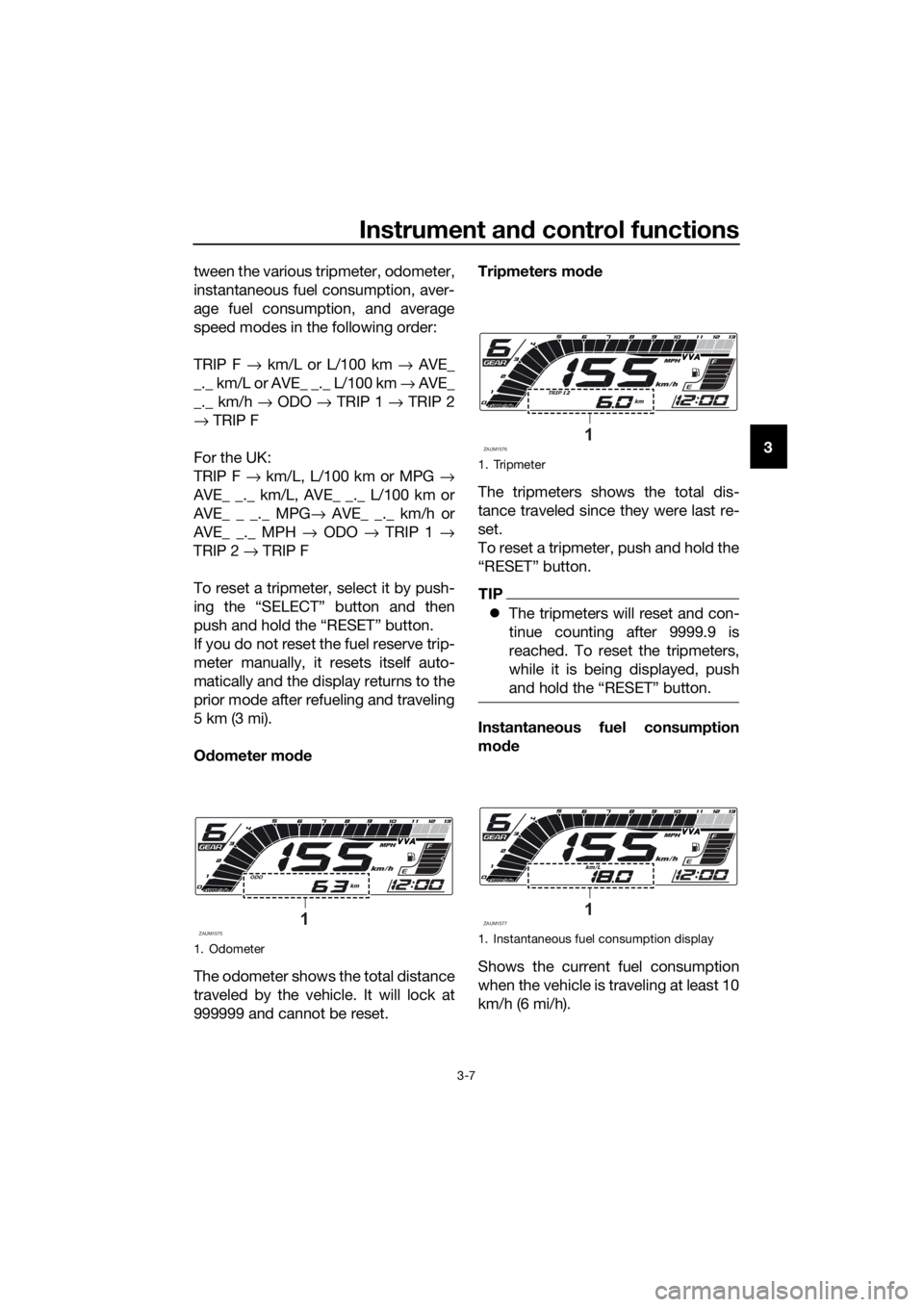
Instrument and control functions
3-7
3 tween the various tripmeter, odometer,
instantaneous fuel consumption, aver-
age fuel consumption, and average
speed modes in the following order:
TRIP F → km/L or L/100 km → AVE_
_._ km/L or AVE_ _._ L/100 km → AVE_
_._ km/h → ODO → TRIP 1 → TRIP 2
→ TRIP F
For the UK:
TRIP F → km/L, L/100 km or MPG →
AVE_ _._ km/L, AVE_ _._ L/100 km or
AVE_ _ _._ MPG→ AVE_ _._ km/h or
AVE_ _._ MPH → ODO → TRIP 1 →
TRIP 2 → TRIP F
To reset a tripmeter, select it by push-
ing the “SELECT” button and then
push and hold the “RESET” button.
If you do not reset the fuel reserve trip-
meter manually, it resets itself auto-
matically and the display returns to the
prior mode after refueling and traveling
5 km (3 mi).
Odometer mode
The odometer shows the total distance
traveled by the vehicle. It will lock at
999999 and cannot be reset.Tripmeters mode
The tripmeters shows the total dis-
tance traveled since they were last re-
set.
To reset a tripmeter, push and hold the
“RESET” button.
TIP
The tripmeters will reset and con-
tinue counting after 9999.9 is
reached. To reset the tripmeters,
while it is being displayed, push
and hold the “RESET” button.
Instantaneous fuel consumption
mode
Shows the current fuel consumption
when the vehicle is traveling at least 10
km/h (6 mi/h).
1. Odometer
ZAUM15751
1. Tripmeter
1. Instantaneous fuel consumption display
ZAUM15761
ZAUM15771
UB6GE0E0.book Page 7 Wednesday, August 28, 2019 11:11 AM
Page 22 of 96
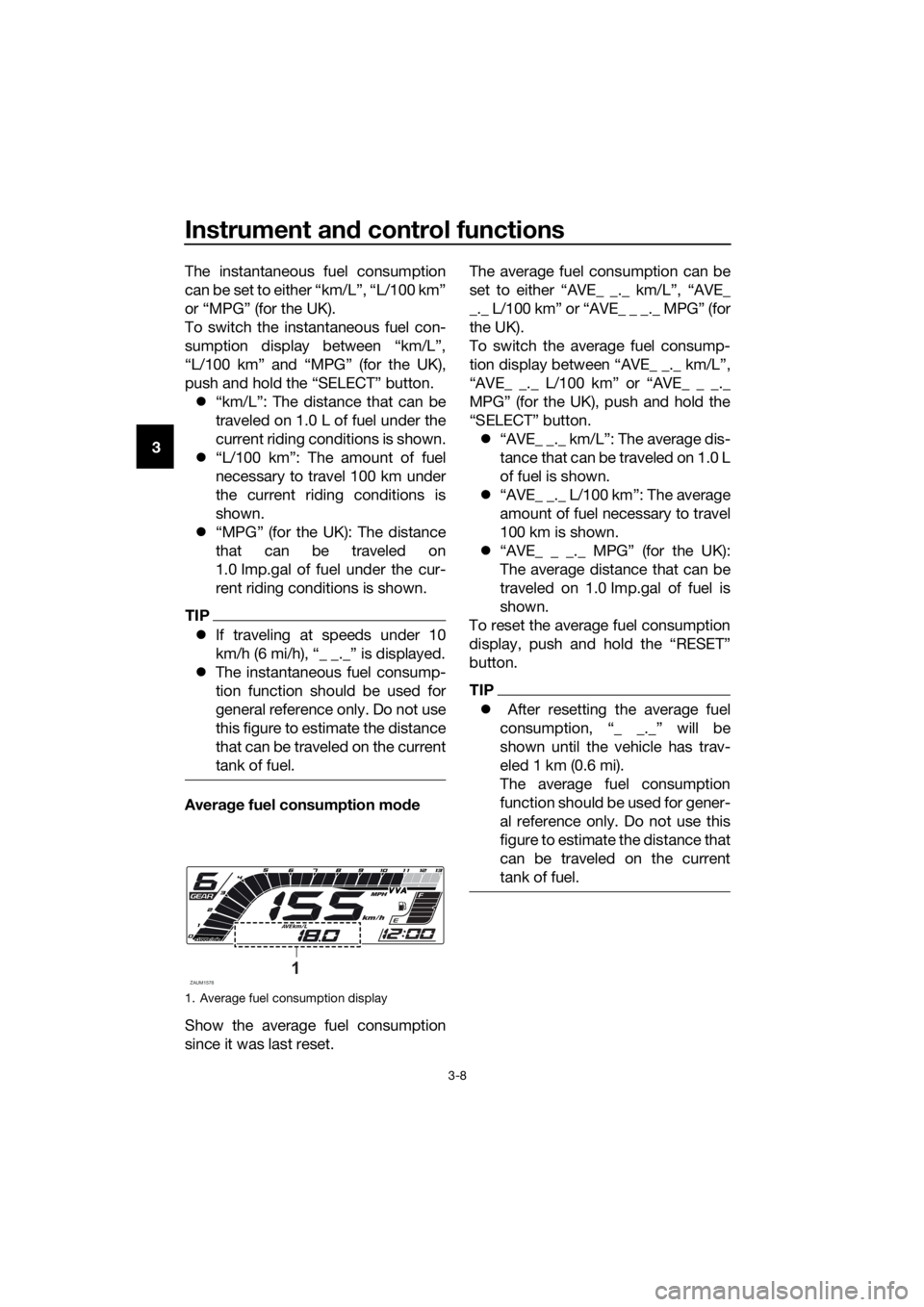
Instrument and control functions
3-8
3The instantaneous fuel consumption
can be set to either “km/L”, “L/100 km”
or “MPG” (for the UK).
To switch the instantaneous fuel con-
sumption display between “km/L”,
“L/100 km” and “MPG” (for the UK),
push and hold the “SELECT” button.
“km/L”: The distance that can be
traveled on 1.0 L of fuel under the
current riding conditions is shown.
“L/100 km”: The amount of fuel
necessary to travel 100 km under
the current riding conditions is
shown.
“MPG” (for the UK): The distance
that can be traveled on
1.0 Imp.gal of fuel under the cur-
rent riding conditions is shown.
TIP
If traveling at speeds under 10
km/h (6 mi/h), “_ _._” is displayed.
The instantaneous fuel consump-
tion function should be used for
general reference only. Do not use
this figure to estimate the distance
that can be traveled on the current
tank of fuel.
Average fuel consumption mode
Show the average fuel consumption
since it was last reset.The average fuel consumption can be
set to either “AVE_ _._ km/L”, “AVE_
_._ L/100 km” or “AVE_ _ _._ MPG” (for
the UK).
To switch the average fuel consump-
tion display between “AVE_ _._ km/L”,
“AVE_ _._ L/100 km” or “AVE_ _ _._
MPG” (for the UK), push and hold the
“SELECT” button.
“AVE_ _._ km/L”: The average dis-
tance that can be traveled on 1.0 L
of fuel is shown.
“AVE_ _._ L/100 km”: The average
amount of fuel necessary to travel
100 km is shown.
“AVE_ _ _._ MPG” (for the UK):
The average distance that can be
traveled on 1.0 Imp.gal of fuel is
shown.
To reset the average fuel consumption
display, push and hold the “RESET”
button.
TIP
After resetting the average fuel
consumption, “_ _._” will be
shown until the vehicle has trav-
eled 1 km (0.6 mi).
The average fuel consumption
function should be used for gener-
al reference only. Do not use this
figure to estimate the distance that
can be traveled on the current
tank of fuel.
1. Average fuel consumption display
ZAUM15781
UB6GE0E0.book Page 8 Wednesday, August 28, 2019 11:11 AM
Page 23 of 96
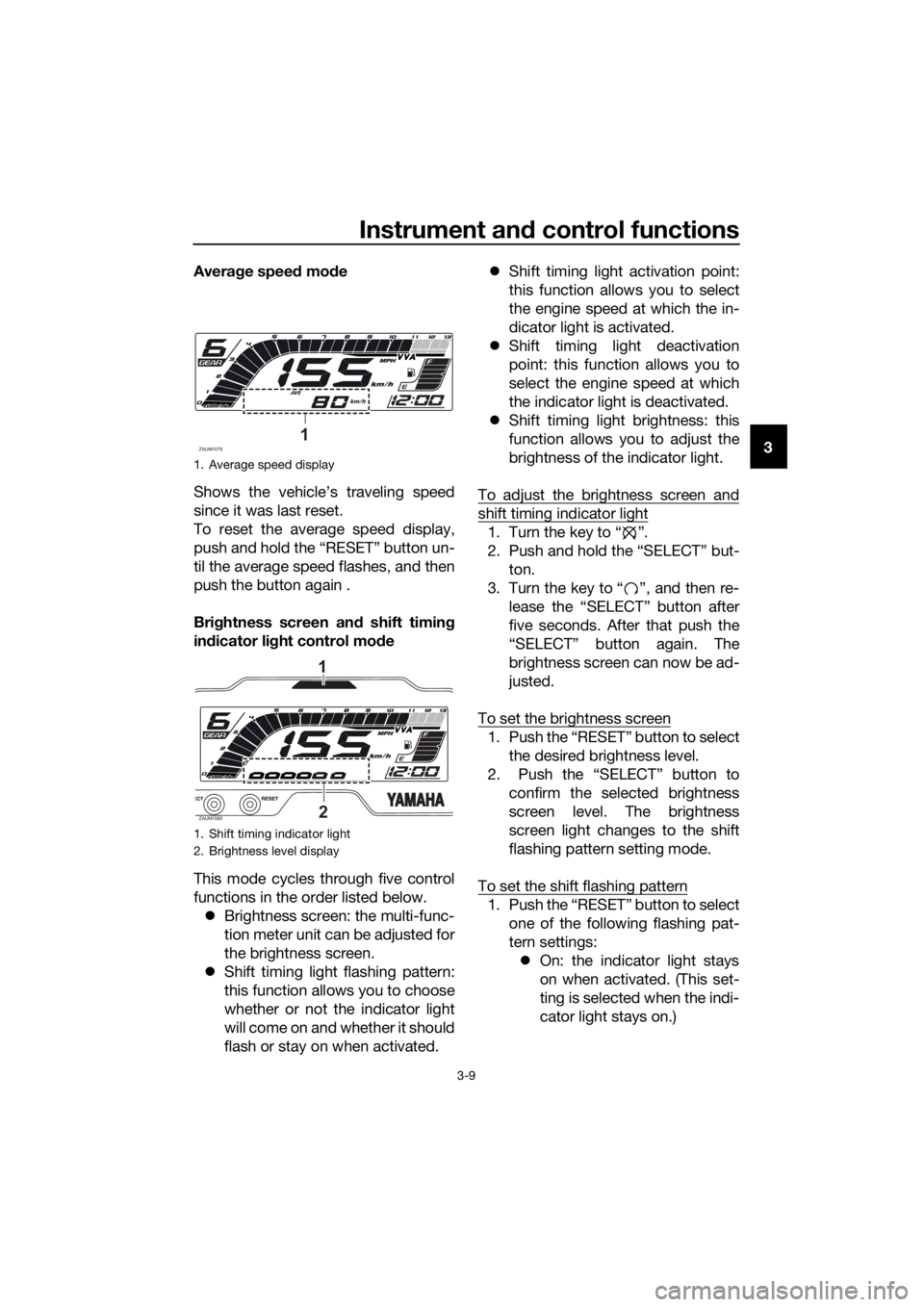
Instrument and control functions
3-9
3 Average speed mode
Shows the vehicle’s traveling speed
since it was last reset.
To reset the average speed display,
push and hold the “RESET” button un-
til the average speed flashes, and then
push the button again .
Brightness screen and shift timing
indicator light control mode
This mode cycles through five control
functions in the order listed below.
Brightness screen: the multi-func-
tion meter unit can be adjusted for
the brightness screen.
Shift timing light flashing pattern:
this function allows you to choose
whether or not the indicator light
will come on and whether it should
flash or stay on when activated.Shift timing light activation point:
this function allows you to select
the engine speed at which the in-
dicator light is activated.
Shift timing light deactivation
point: this function allows you to
select the engine speed at which
the indicator light is deactivated.
Shift timing light brightness: this
function allows you to adjust the
brightness of the indicator light.
To adjust the brightness screen and
shift timing indicator light
1. Turn the key to “ ”.
2. Push and hold the “SELECT” but-
ton.
3. Turn the key to “ ”, and then re-
lease the “SELECT” button after
five seconds. After that push the
“SELECT” button again. The
brightness screen can now be ad-
justed.
To set the brightness screen
1. Push the “RESET” button to select
the desired brightness level.
2. Push the “SELECT” button to
confirm the selected brightness
screen level. The brightness
screen light changes to the shift
flashing pattern setting mode.
To set the shift flashing pattern
1. Push the “RESET” button to select
one of the following flashing pat-
tern settings:
On: the indicator light stays
on when activated. (This set-
ting is selected when the indi-
cator light stays on.)
1. Average speed display
1. Shift timing indicator light
2. Brightness level display
ZAUM15791
ZAUM15802
1
UB6GE0E0.book Page 9 Wednesday, August 28, 2019 11:11 AM
Page 24 of 96

Instrument and control functions
3-10
3Flash: the indicator light
flashes when activated. (This
setting is selected when the
indicator light flashes four
times per second.)
Off: the indicator light is deac-
tivated; in other words, it
does not come on or flash.
(This setting is selected when
the indicator light flashes
once every two seconds.)
2. Push the “SELECT” button to con-
firm the selected flashing pattern.
The shift timing indicator light
changes to the activation point
setting mode.
The tachometer will show the current
setting r/min for the activation point
and deactivation point setting modes.
To set the shift activation point
TIP
The shift timing indicator light activa-
tion point can be set between 9000
r/min and 13000 r/min. The indicator
light can be set in increments of 500
r/min.
1.
the desired engine speed for acti-
vating the indicator light.
2.
firm the selected engine speed.
The control mode changes to the
deactivation point setting mode.To set the shift deactivation point
TIP
The shift timing indicator light de-
activation point can be set be-
tween 9000 r/min and 13000
r/min. The indicator light can be
set in increments of 500 r/min.
Be sure to set the deactivation
point to a higher engine speed
than for the activation point, other-
wise the shift timing indicator light
will not come on.
1. Push the “RESET” button to select
the desired engine speed for de-
activating the indicator light.
2. Push the “SELECT” button to con-
firm the selected engine speed.
The control mode changes to the
brightness setting mode.
To adjust the shift brightness
1. Push the “RESET” button to select
the desired shift indicator light
brightness level.
2. Push the “SELECT” button to con-
firm the selected brightness level.
The display exits the shift timing
light control mode and returns to
the standard multi-function dis-
play mode.
Welcome screen
The welcome screen greets the rider
when the key is turned to “ ” with the
messages “Hi Buddy” and “see you”
when the key is turned to “ ”. The
user name “Buddy” is set as the facto-
ry default, but it can be set to your
name.
UB6GE0E0.book Page 10 Wednesday, August 28, 2019 11:11 AM
Page 25 of 96
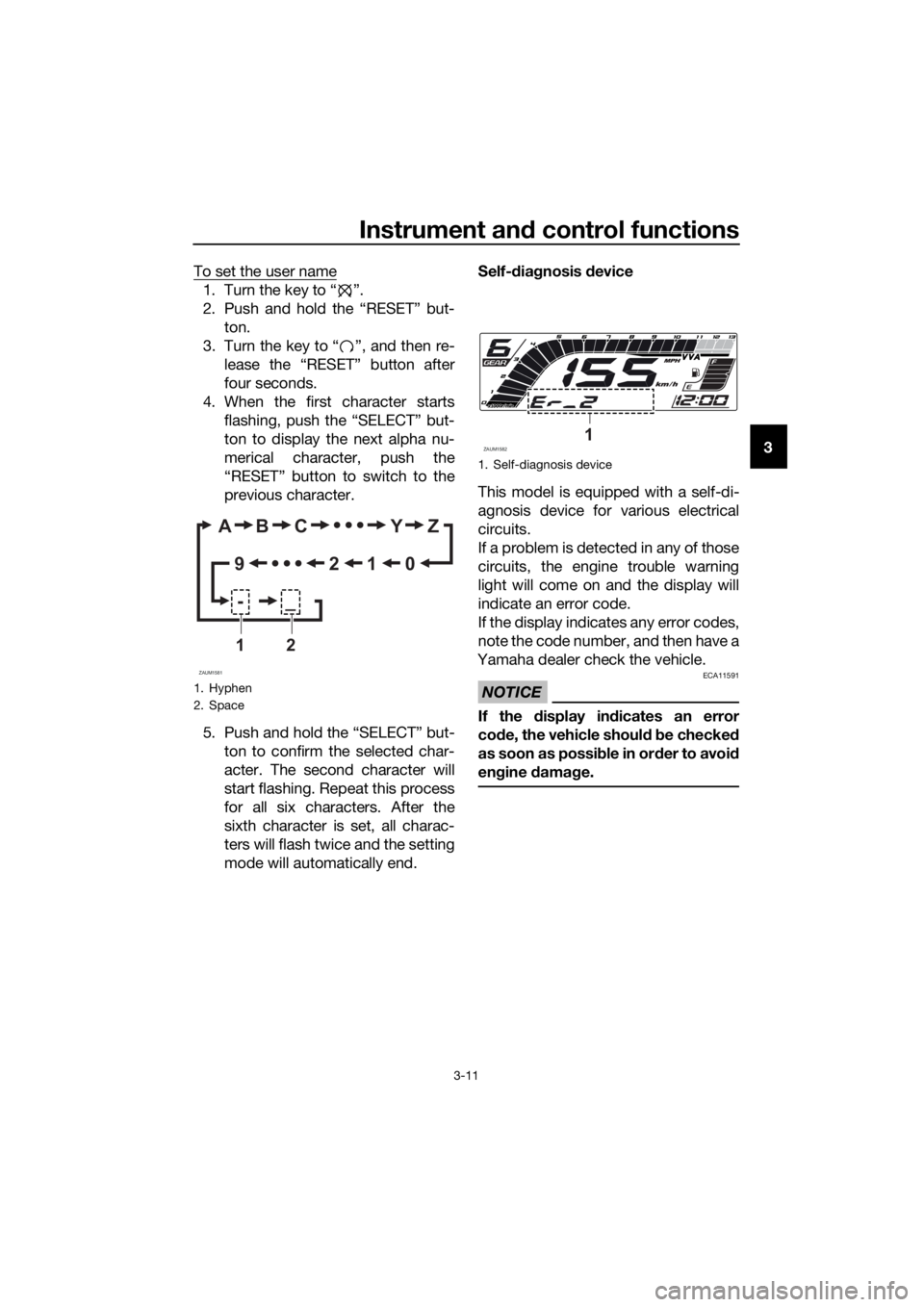
Instrument and control functions
3-11
3 To set the user name
1. Turn the key to “ ”.
2. Push and hold the “RESET” but-
ton.
3. Turn the key to “ ”, and then re-
lease the “RESET” button after
four seconds.
4. When the first character starts
flashing, push the “SELECT” but-
ton to display the next alpha nu-
merical character, push the
“RESET” button to switch to the
previous character.
5. Push and hold the “SELECT” but-
ton to confirm the selected char-
acter. The second character will
start flashing. Repeat this process
for all six characters. After the
sixth character is set, all charac-
ters will flash twice and the setting
mode will automatically end.Self-diagnosis device
This model is equipped with a self-di-
agnosis device for various electrical
circuits.
If a problem is detected in any of those
circuits, the engine trouble warning
light will come on and the display will
indicate an error code.
If the display indicates any error codes,
note the code number, and then have a
Yamaha dealer check the vehicle.
NOTICE
ECA11591
If the display indicates an error
code, the vehicle should be checked
as soon as possible in order to avoid
engine damage.
1. Hyphen
2. Space
ZAUM1581
AB C Y Z
0 1 2 9
-_
12
1. Self-diagnosis device
ZAUM15821
UB6GE0E0.book Page 11 Wednesday, August 28, 2019 11:11 AM
Page 26 of 96
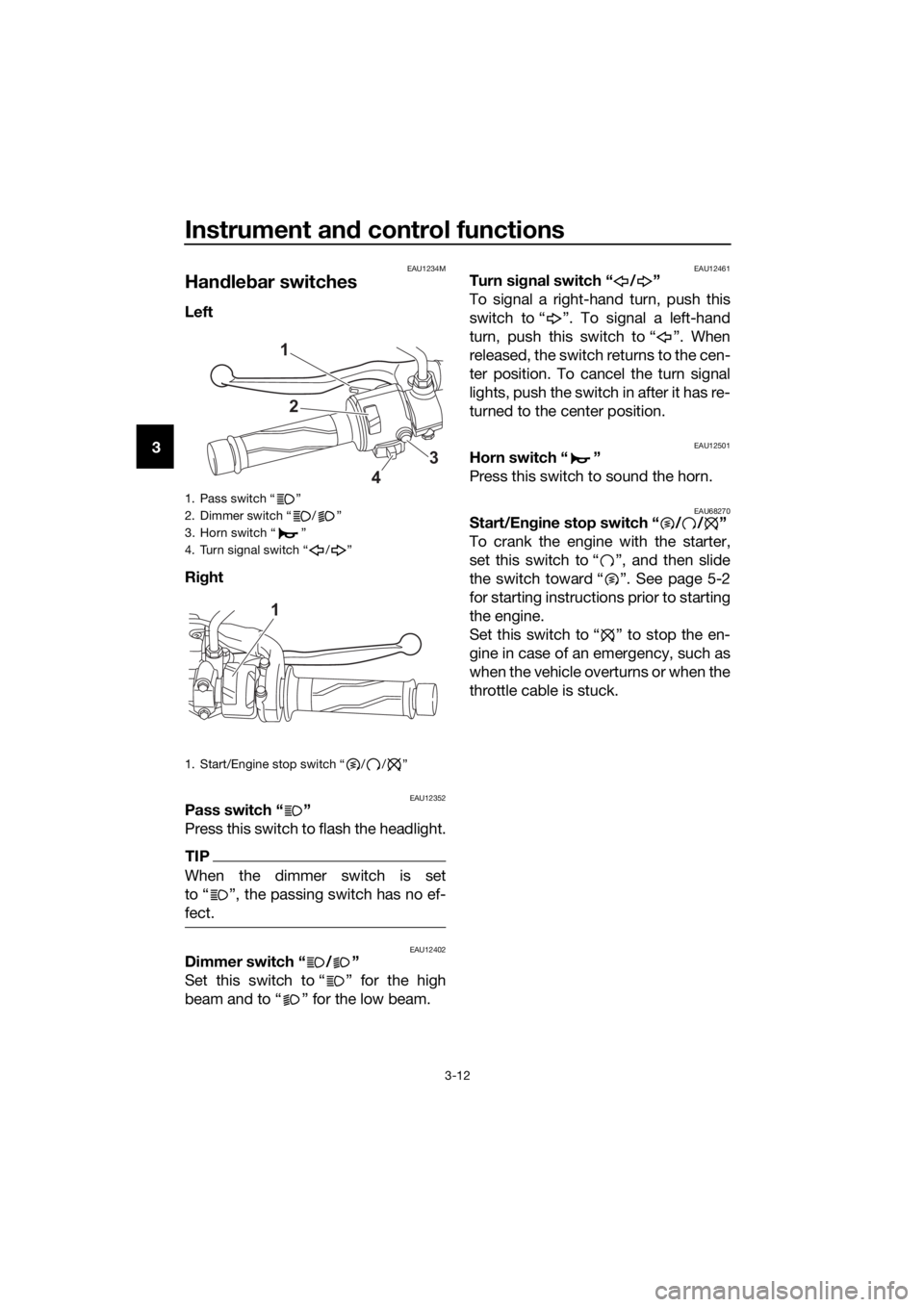
Instrument and control functions
3-12
3
EAU1234M
Handlebar switches
Left
Right
EAU12352Pass switch “ ”
Press this switch to flash the headlight.
TIP
When the dimmer switch is set
to Ž, the passing switch has no ef-
fect.
EAU12402Dimmer switch “ / ”
Set this switch to “ ” for the high
beam and to “ ” for the low beam.
EAU12461Turn signal switch “ / ”
To signal a right-hand turn, push this
switch to “ ”. To signal a left-hand
turn, push this switch to “ ”. When
released, the switch returns to the cen-
ter position. To cancel the turn signal
lights, push the switch in after it has re-
turned to the center position.
EAU12501Horn switch “ ”
Press this switch to sound the horn.
EAU68270Start/Engine stop switch “ / / ”
To crank the engine with the starter,
set this switch to “ ”, and then slide
the switch toward “ ”. See page 5-2
for starting instructions prior to starting
the engine.
Set this switch to “ ” to stop the en-
gine in case of an emergency, such as
when the vehicle overturns or when the
throttle cable is stuck.
1. Pass switch “ ”
2. Dimmer switch “ / ”
3. Horn switch “ ”
4. Turn signal switch “ / ”
1. Start/Engine stop switch “ / / ”
1
2
3
4
1
UB6GE0E0.book Page 12 Wednesday, August 28, 2019 11:11 AM
Page 27 of 96
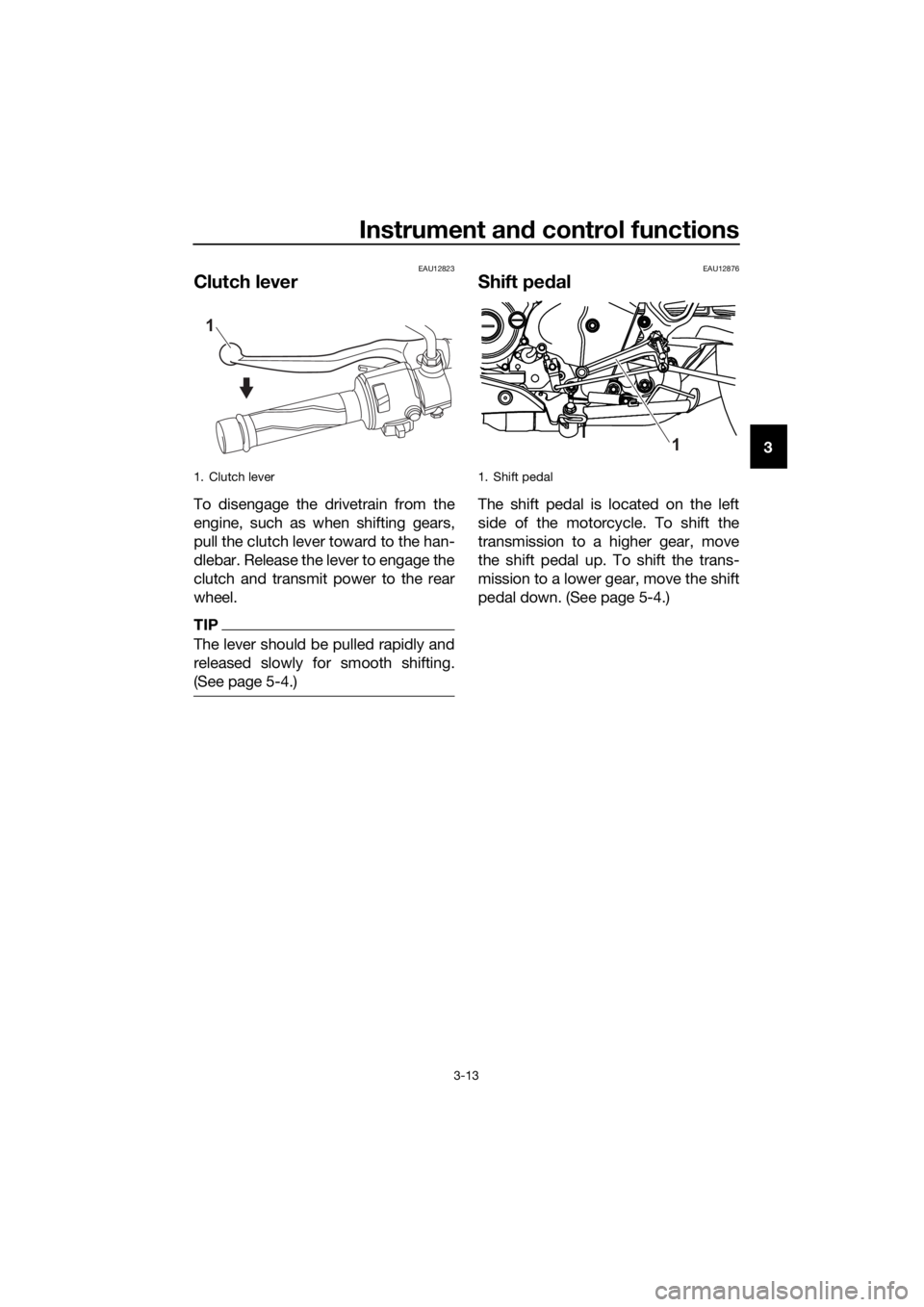
Instrument and control functions
3-13
3
EAU12823
Clutch lever
To disengage the drivetrain from the
engine, such as when shifting gears,
pull the clutch lever toward to the han-
dlebar. Release the lever to engage the
clutch and transmit power to the rear
wheel.
TIP
The lever should be pulled rapidly and
released slowly for smooth shifting.
(See page 5-4.)
EAU12876
Shift pedal
The shift pedal is located on the left
side of the motorcycle. To shift the
transmission to a higher gear, move
the shift pedal up. To shift the trans-
mission to a lower gear, move the shift
pedal down. (See page 5-4.)
1. Clutch lever
1
1. Shift pedal
1
UB6GE0E0.book Page 13 Wednesday, August 28, 2019 11:11 AM
Page 28 of 96
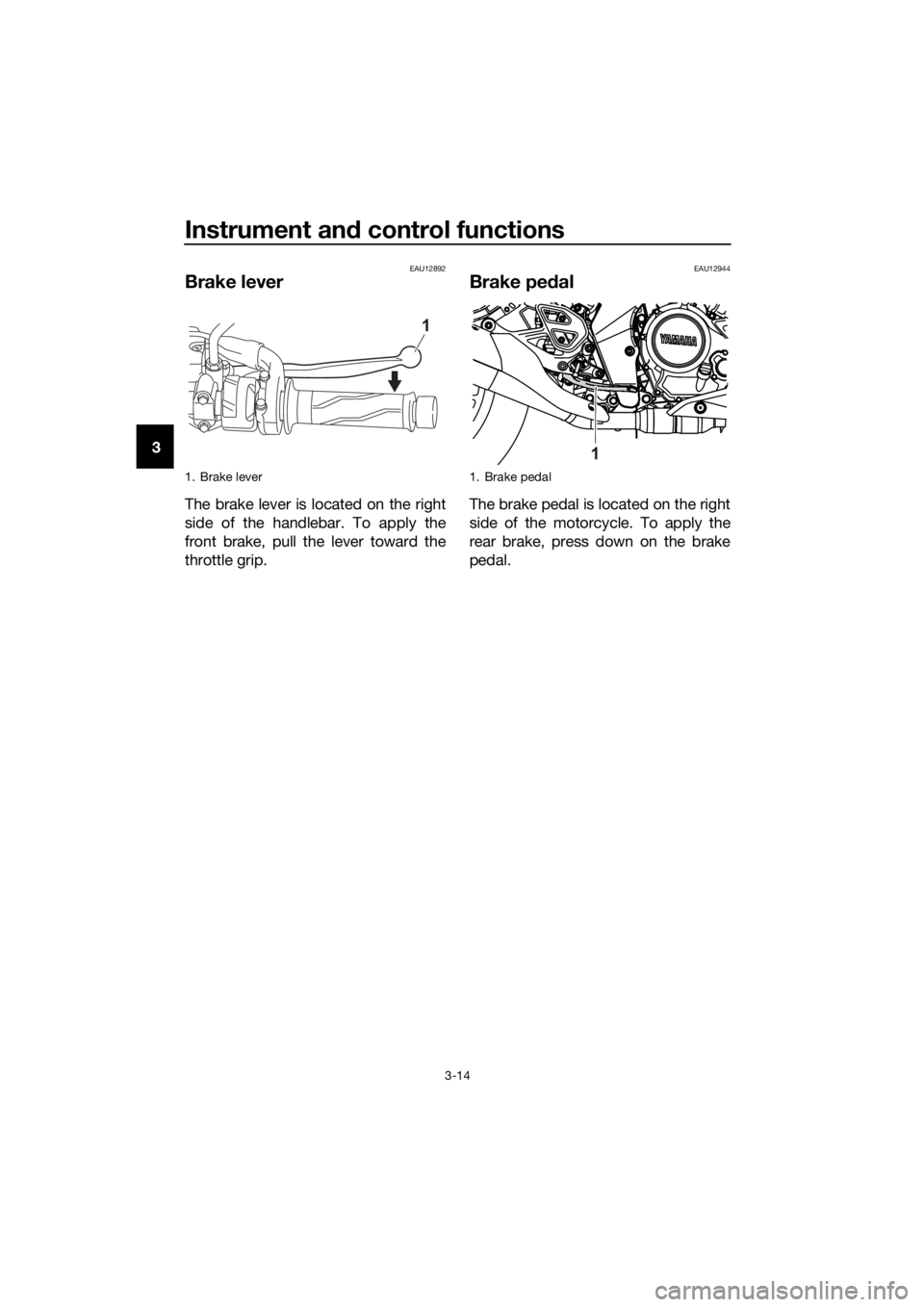
Instrument and control functions
3-14
3
EAU12892
Brake lever
The brake lever is located on the right
side of the handlebar. To apply the
front brake, pull the lever toward the
throttle grip.
EAU12944
Brake pedal
The brake pedal is located on the right
side of the motorcycle. To apply the
rear brake, press down on the brake
pedal.
1. Brake lever
1
1. Brake pedal
1
UB6GE0E0.book Page 14 Wednesday, August 28, 2019 11:11 AM
Page 29 of 96
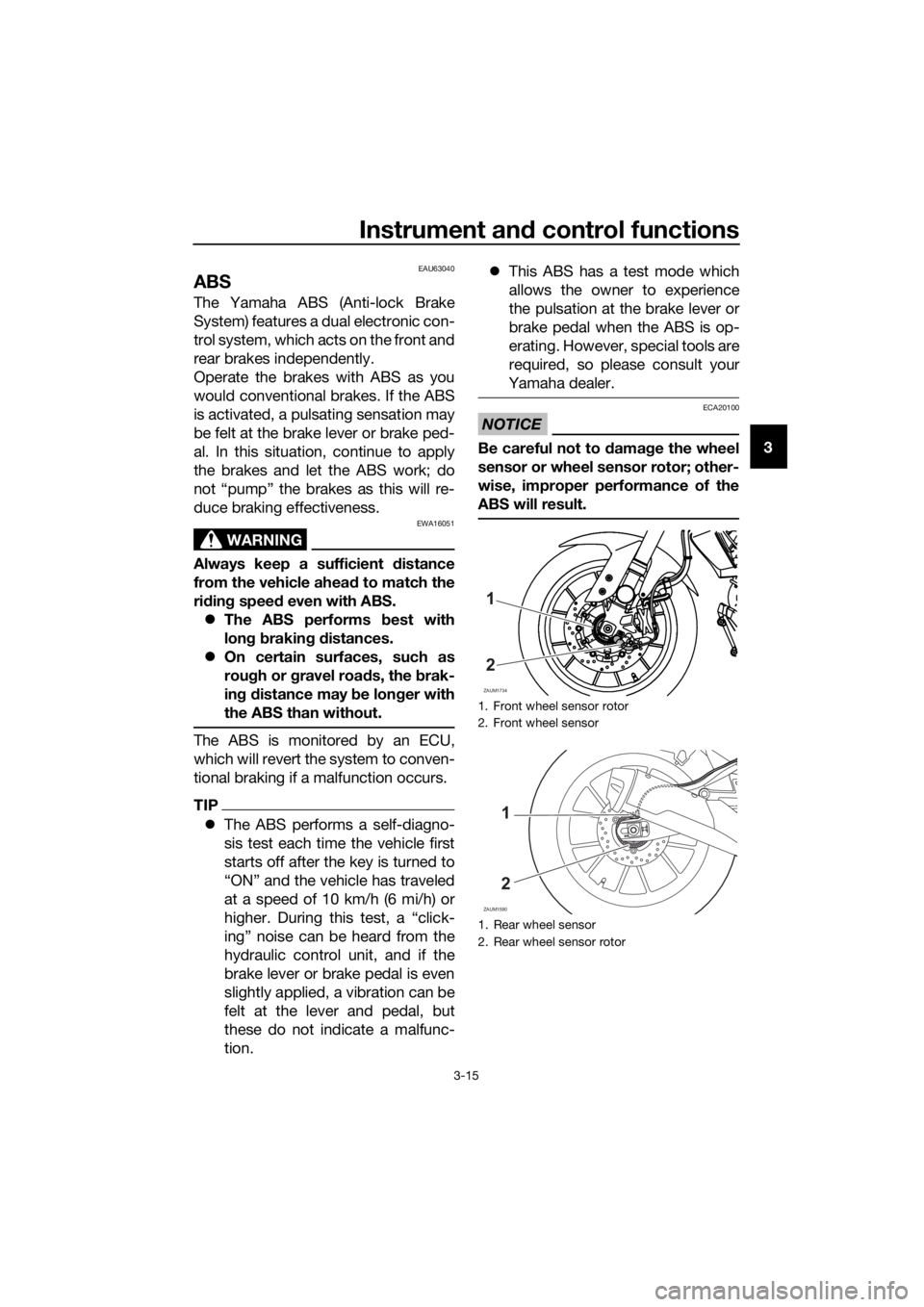
Instrument and control functions
3-15
3
EAU63040
ABS
The Yamaha ABS (Anti-lock Brake
System) features a dual electronic con-
trol system, which acts on the front and
rear brakes independently.
Operate the brakes with ABS as you
would conventional brakes. If the ABS
is activated, a pulsating sensation may
be felt at the brake lever or brake ped-
al. In this situation, continue to apply
the brakes and let the ABS work; do
not “pump” the brakes as this will re-
duce braking effectiveness.
WARNING
EWA16051
Always keep a sufficient distance
from the vehicle ahead to match the
riding speed even with ABS.
The ABS performs best with
long braking distances.
On certain surfaces, such as
rough or gravel roads, the brak-
ing distance may be longer with
the ABS than without.
The ABS is monitored by an ECU,
which will revert the system to conven-
tional braking if a malfunction occurs.
TIP
The ABS performs a self-diagno-
sis test each time the vehicle first
starts off after the key is turned to
“ON” and the vehicle has traveled
at a speed of 10 km/h (6 mi/h) or
higher. During this test, a “click-
ing” noise can be heard from the
hydraulic control unit, and if the
brake lever or brake pedal is even
slightly applied, a vibration can be
felt at the lever and pedal, but
these do not indicate a malfunc-
tion.This ABS has a test mode which
allows the owner to experience
the pulsation at the brake lever or
brake pedal when the ABS is op-
erating. However, special tools are
required, so please consult your
Yamaha dealer.
NOTICE
ECA20100
Be careful not to damage the wheel
sensor or wheel sensor rotor; other-
wise, improper performance of the
ABS will result.
1. Front wheel sensor rotor
2. Front wheel sensor
1. Rear wheel sensor
2. Rear wheel sensor rotor
ZAUM1734
1
2
ZAUM1590
1
2
UB6GE0E0.book Page 15 Wednesday, August 28, 2019 11:11 AM
Page 30 of 96

Instrument and control functions
3-16
3
EAU13076
Fuel tank cap
To open the fuel tank cap
Open the fuel tank cap lock cover, in-
sert the key into the lock, and then turn
it 1/4 turn clockwise. The lock will be
released and the fuel tank cap can be
opened.
To close the fuel tank cap
With the key still inserted in the lock,
push down the fuel tank cap. Turn the
key 1/4 turn counterclockwise, remove
it, and then close the lock cover.
TIP
The fuel tank cap cannot be closed un-
less the key is in the lock. In addition,
the key cannot be removed if the cap is
not properly closed and locked.
WARNING
EWA11092
Make sure that the fuel tank cap is
properly closed after filling fuel.
Leaking fuel is a fire hazard.
EAU13213
Fuel
Make sure there is sufficient gasoline in
the tank.
WARNING
EWA10882
Gasoline and gasoline vapors are
extremely flammable. To avoid fires
and explosions and to reduce the
risk of injury when refueling, follow
these instructions.
1. Before refueling, turn off the en-
gine and be sure that no one is sit-
ting on the vehicle. Never refuel
while smoking, or while in the vi-
cinity of sparks, open flames, or
other sources of ignition such as
the pilot lights of water heaters
and clothes dryers.
2. Do not overfill the fuel tank. Stop
filling when the fuel reaches the
bottom of the filler tube. Because
fuel expands when it heats up,
heat from the engine or the sun
can cause fuel to spill out of the
fuel tank.
3. Wipe up any spilled fuel immedi-
ately. NOTICE: Immediately
wipe off spilled fuel with a clean,1. Fuel tank cap lock cover
2. Unlock.
1
2
1. Fuel tank filler tube
2. Maximum fuel level
1
2
UB6GE0E0.book Page 16 Wednesday, August 28, 2019 11:11 AM